If there’s one company that has consistently pushed the boundaries of what’s possible in the observability market, it’s undeniably Datadog. Since its inception in 2010, the monitoring and security platform has been on a mission to revolutionize the way businesses optimize their cloud infrastructure, and its relentless pursuit of excellence has paid off in a big way.
Year after year, Datadog has introduced cutting-edge observability features that help developers gain a unified view of their IT infrastructure, enabling them to observe, troubleshoot, and enhance their cloud applications like never before. Most recently, they hopped onto the AI bandwagon, offering LLM Observability, Bits AI, and Data Jobs Monitoring, further solidifying its position as a leader in the field. In fact, the company currently boasts a customer base that has expanded to approximately 28,700, with 3,390 of them spending at least $100,000 on Datadog’s services.
But scratch beneath the surface, and there’s one major gripe that even the most devoted Datadog fan can’t ignore: its pricing model! Datadog provides a wide range of products, including infrastructure monitoring, log monitoring, application monitoring, security, and more, with varied pricing. These products cater to various use cases, and many feature add-ons that enhance functionality, capabilities, and cost. The key principle to grasp is simple: the more you use, the more you pay.
Ironically, Datadog lacks observability into its own costs, making it challenging to reason about, optimize, and receive alerts on ominous increases. Regardless of how many people love it, the inevitable “bill shock” gets everyone!
Curious about the true costs of Datadog? Wondering if it’s worth the investment in 2025? Dive into the details with us at Middleware, where we’ll break down their pricing and compare it to our own services. We hope this helps you make an informed decision and optimize your observability costs.
Pricing overview
As mentioned, Datadog’s pricing model is based on a tiered structure, with different levels of features and resources available depending on the selected plan. As you move up the tiers, the pricing increases, allowing for more extensive functionality and higher data volumes. Although this may initially seem beneficial for large enterprises with complex monitoring needs, it actually lacks stability and is ultimately too expensive.
The billing cycle starts on the first of the month (UTC), regardless of your sign-up date, with the first month prorated accordingly. Hosts and custom metrics are metered hourly, and the billable count of hosts is calculated at the end of the month using the maximum count (high-water mark) of the lower 99% of usage, excluding spikes. Similarly, the billable count of custom metrics is based on the average number of custom metric hours for the month. Unfortunately, access to the billing pages is limited to users with the Datadog Admin Role.
How on earth do people deal with Datadog’s billing practices?
byu/ycnz insysadmin
Middleware, on the other hand, takes a different approach to pricing. For a limited time, all services are completely free of charge, allowing you to experience the benefits of a cloud-based unified observability solution and effortlessly scale your infrastructure.
After this period, Middleware follows a pay-as-you-go pricing plan, where costs are calculated based on actual usage rather than peak usage. This approach allows for significant cost savings, up to 5 times compared to Datadog pricing. Middleware’s pricing is transparent, with no traditional pricing tiers, and full access to all features without restrictions. Each use case has its own associated cost, ensuring that you only pay for what you use. Regardless of how you choose to utilize or prioritize your data, you gain full access to all Middleware features without any restrictions.
Log monitoring
Both Datadog and Middleware offer robust log monitoring features, including seamless correlation with full context in an integrated platform and AI-based log alerts, among others. Let’s compare their log monitoring pricing.
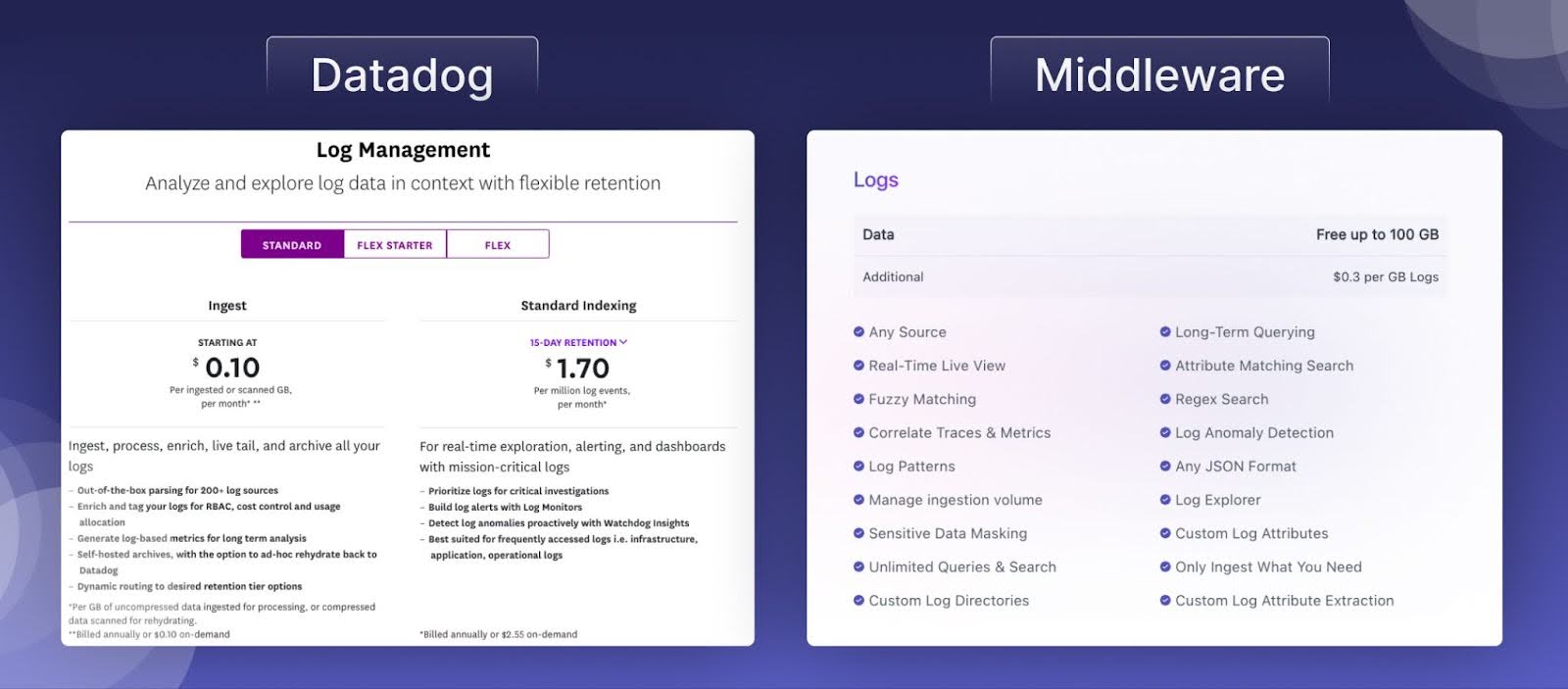
Datadog’s log monitoring pricing
Datadog offers two log monitoring plans: Ingest and Standard Indexing.
- The Ingest plan allows for real-time log data processing, enrichment, and structuring, with pricing based on the amount of uncompressed data ingested or compressed data scanned, charged per GB. It starts at $0.10 per ingested or scanned GB/Month.
- The standard indexing plan provides simplified pricing based on retention, offering better cost control, log patterns, and analytics for easy trend identification. Currently, it starts from $1.06 per million log events/Month billed annually or $1.59 on-demand.
As Datadog’s log pricing is volume-based, charging per GB of uncompressed data ingested, users teams with large log volumes can expect high costs.
Middleware’s log monitoring pricing
Middleware offers a comprehensive log monitoring solution with a competitive pricing model. Unlike Datadog, Middleware provides a more generous free tier, allowing users to ingest up to 100 GB of log data without incurring costs. Additional log data is charged at $0.3 per GB, which is relatively affordable compared to Datadog’s Ingest plan.
Middleware’s log monitoring features are on par with Datadog, offering a real-time live view, attribute matching search, fuzzy matching, regex search, and log anomaly detection. Additionally, Middleware provides log patterns, supports any JSON format, and allows for custom log attributes and directories. The platform offers sensitive data masking, custom log attribute extraction, and unlimited queries and searches.
One of the standout features of Middleware is its focus on flexibility and customization. Users can manage ingestion volume, correlate traces and metrics, and only ingest what they need. This level of control, combined with its competitive pricing, makes Middleware an attractive option for businesses seeking a robust log management solution without breaking the bank.
Application performance monitoring (APM)
Datadog and Middleware provide various APM features, including end-to-end visibility for monitoring application performance. APM enables the rapid identification and resolution of root-cause issues by using correlated traces. It also allows for pinpointing the source of issues through code-level distributed tracing.
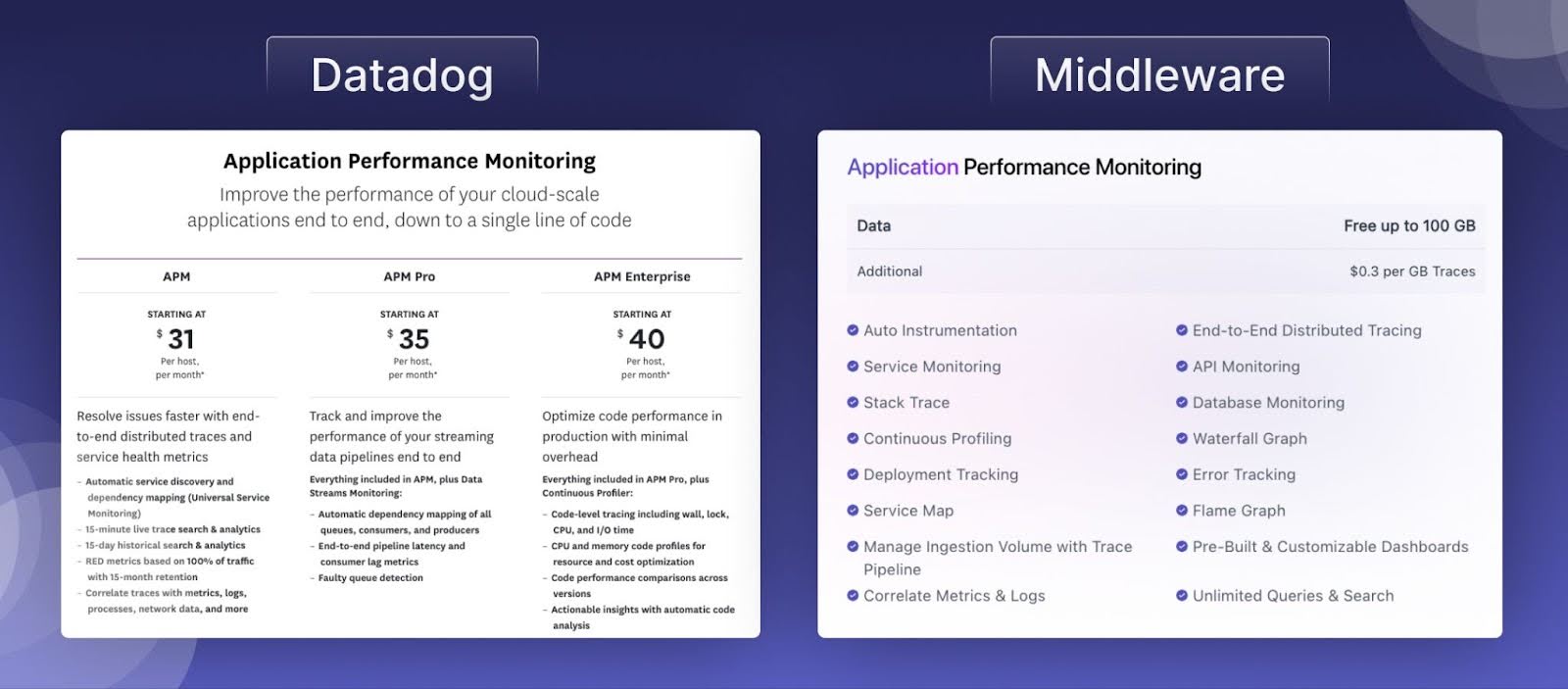
Datadog’s APM pricing
Datadog offers three pricing models for its Application Performance Monitoring (APM) solution:
- APM starts at $31 per host per month, providing end-to-end distributed traces, service health metrics, and automatic service discovery.
- APM Pro starts at $35 per host per month, including everything in APM plus data stream monitoring for tracking and improving streaming data pipelines.
- APM Enterprise starts at $40 per host per month, adding a Continuous Profiler for optimizing code performance in production with code-level tracing and actionable insights.
Overall, teams with large numbers of hosts can incur significant costs.
Middleware’s APM pricing
Middleware’s APM pricing, on the other hand, includes 100 GB free, with additional data charged at $0.3 per GB. This provides a more cost-effective solution for teams with large data volumes.
Middleware’s pricing provides a clear advantage, offering a more cost-effective solution for monitoring a larger number of hosts. In addition to the pricing comparison, it’s worth noting that Datadog has an additional requirement for their APM solution. Every billable APM, APM Pro, or APM Enterprise host in Datadog necessitates the purchase of Pro or Enterprise Infrastructure Monitoring.
However, it’s important to consider other factors, such as feature sets, scalability, and the team or organization’s specific needs, when deciding which APM solution to choose.
Real user monitoring (RUM)
RUM involves monitoring the actual end users of your applications, enabling you to track and address issues that arise during the usage of your mobile or browser applications. This service proves invaluable for conducting UI testing and debugging processes.
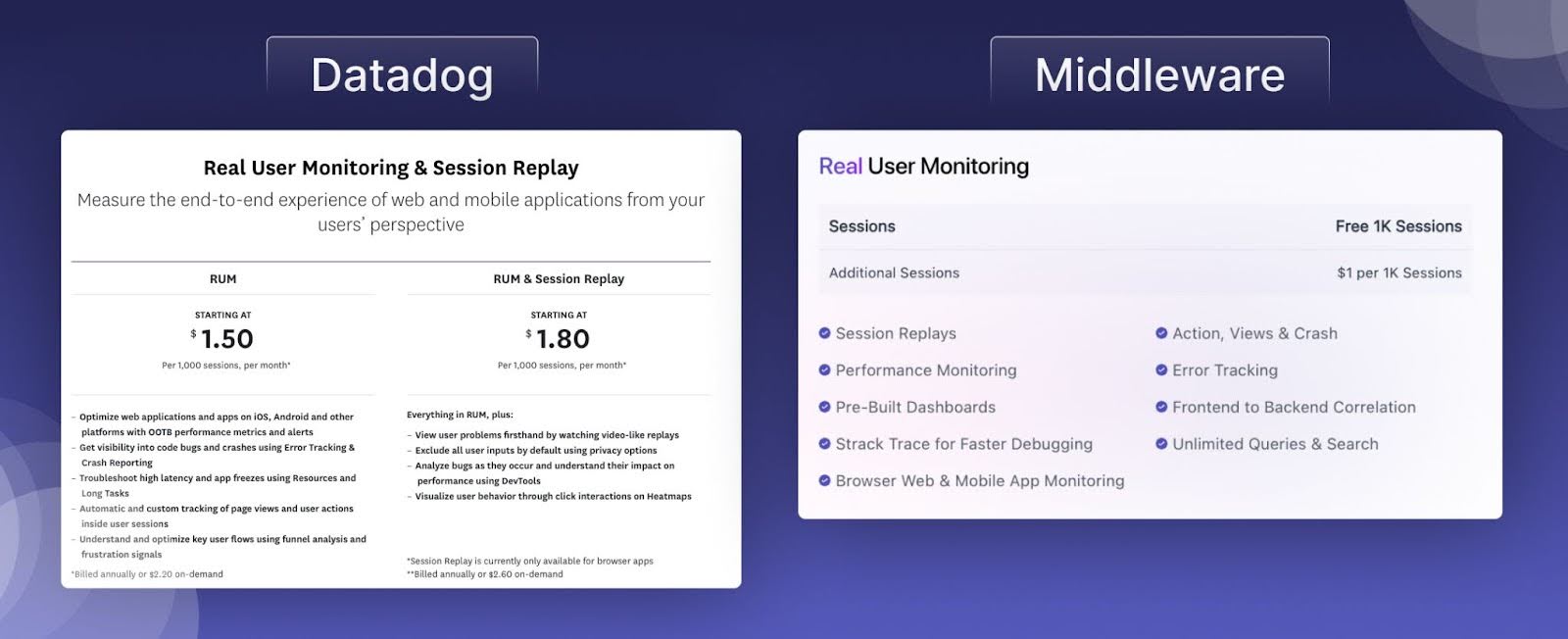
Datadog’s RUM pricing
Datadog’s RUM pricing starts at $1.50 per 1,000 sessions per month, billed annually, or $2.20 on-demand. This plan offers end-to-end experience measurement for web and mobile applications, out-of-the-box performance metrics and alerts, error tracking and crash reporting, and more. Nonetheless, it can be a significant cost for teams with large numbers of users.
The RUM & Session Replay plan starts at $1.80 per 1,000 sessions per month, billed annually, or $2.60 on-demand, and includes all RUM features plus video-like replays of user sessions, privacy options, DevTools for analyzing bugs, and Heatmaps for visualizing user behavior. Note that Session Replay is currently only available for browser apps.
Middleware’s RUM pricing
On the other hand, Middleware’s RUM pricing is straightforward, offering 1,000 sessions per month for free, with additional sessions costing $1 per 1,000 sessions per month.
This plan includes a comprehensive set of features, such as session replays, performance monitoring, error tracking, pre-built dashboards, frontend to backend correlation, stack trace for faster debugging, unlimited queries and search, and browser, web, and mobile app monitoring. With no annual billing or on-demand pricing mentioned, Middleware’s pricing model is pay-as-you-go, based solely on the number of sessions used.
Infrastructure monitoring
Infrastructure monitoring involves monitoring the health, performance, and availability of your IT infrastructure components, such as servers, networks, databases, and applications.
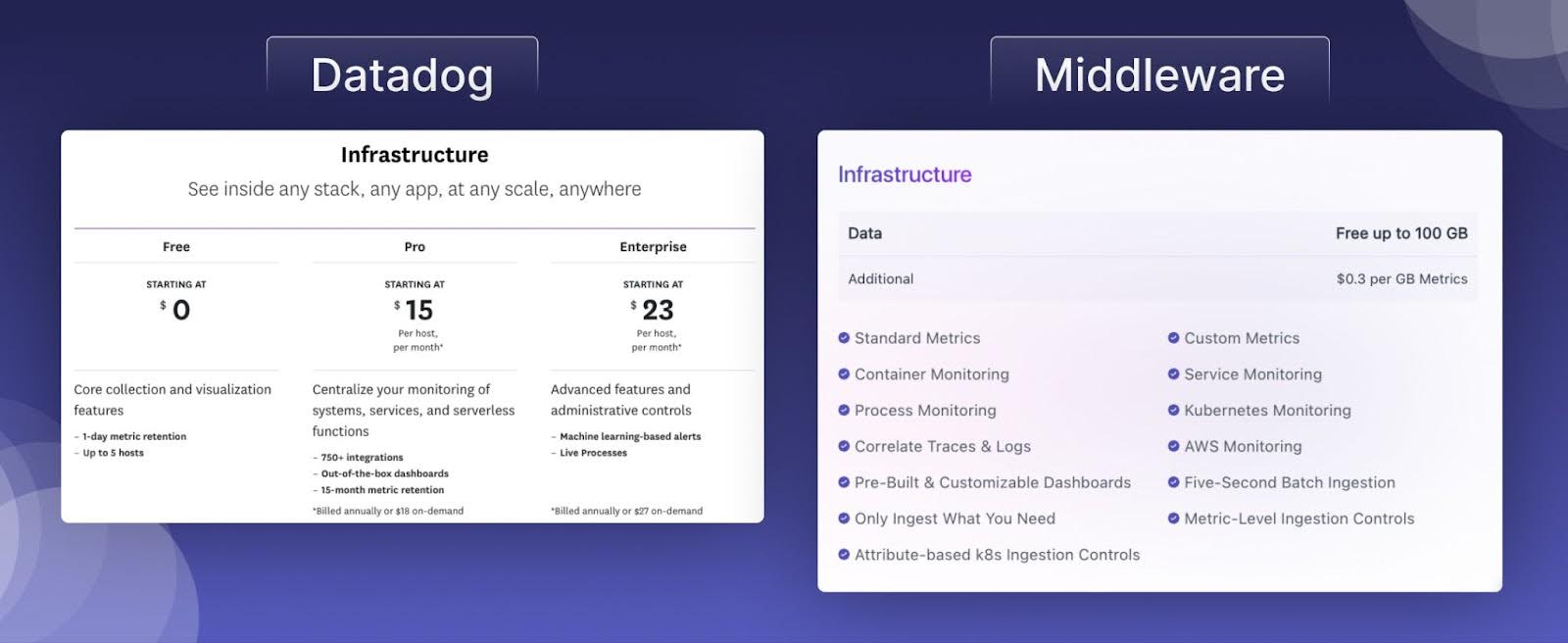
Datadog’s infrastructure monitoring pricing
Datadog’s Infrastructure monitoring offers a range of pricing plans to suit different needs.
- The free plan includes core collection and visualization features, 1-day metric retention, and support for up to 5 hosts.
- The Pro plan starts at $15 per host per month (billed annually) and offers additional features like 750+ integrations, out-of-the-box dashboards, and 15-month metric retention.
- The Enterprise plan starts at $23 per host per month (billed annually) and includes advanced features like machine learning-based alerts and live processes. Additionally, Datadog offers two DevSecOps plans, Pro and Enterprise, which include features like continuous scanning for misconfigurations, vulnerability management, and compliance frameworks, starting at $22 and $34 per host per month (billed annually).
Middleware’s infrastructure monitoring pricing
Middleware’s Infrastructure monitoring offers a free tier of up to 100 GB, making it an attractive option for small to medium-sized businesses. For additional data, the pricing is $0.3 per GB, providing a cost-effective solution for larger enterprises. Middleware’s infrastructure monitoring capabilities include container monitoring, service monitoring, and Kubernetes monitoring.
The flexible pricing model allows businesses to ingest only what they need, with metric-level and attribute-based controls for Kubernetes ingestion, making it a scalable and affordable choice for infrastructure monitoring needs.
Synthetic monitoring
Synthetic monitoring involves simulating user interactions with applications or websites to monitor their performance and availability. It helps businesses proactively identify issues, optimize user experiences, and ensure reliable application delivery.
Datadog’s synthetic monitoring pricing
Datadog’s Synthetic Monitoring pricing offers a tiered structure across API, Browser, and Mobile App Testing.
- API Testing starts at $5 per 10,000 test runs per month
- Browser Testing at $12 per 1,000 test runs per month
- Mobile App Testing at $50 per 100 test runs per month.
Additional parallelization for Continuous Testing is available as an add-on starting at $79 per month.
All prices are discounted for annual billing, with on-demand options available at a higher rate. This pricing model allows users to choose the level of testing that suits their needs, with the flexibility to scale up or down as required.
Middleware’s synthetic monitoring pricing
Middleware’s synthetic monitoring pricing, on the other hand, includes 20,000 checks free, with additional checks charged at $1 per 5,000 checks. This provides a more cost-effective solution for teams with large numbers of tests. Middleware’s synthetic monitoring capabilities include API and multi-step API testing.
Custom metrics pricing
By extracting meaningful information from your log data, custom metrics can help you gain deeper insights into your application’s behavior and performance.
Datadog’s Pricing
Datadog’s custom pricing can be intricate, so understanding how it works is important. A custom metric in Datadog is distinguished by a combination of a metric name and tag values, including the host tag. Whenever you send a metric using DogStatsD or through a custom Agent Check, it is considered a custom metric.
To calculate the monthly billable count for custom metrics, Datadog takes the sum of all distinct custom metrics for each hour in a given month. This sum is then divided by the number of hours in the month to obtain the monthly average value, which is reflected on the Usage page and contributes to your billing.
Confused right? Unlike the complexity of custom pricing with Datadog, Middleware keeps it simple and offers free custom metrics.
Middleware’s Pricing
Middleware doesn’t charge you anything for custom metrics. In fact, you can create a custom dashboard with infrastructure metrics and custom log metrics for free. Additionally, Middleware’s custom metrics capabilities include metric-level ingestion controls.
Datadog v/s Middleware
Here’s a side-by-side comparison of Datadog v/s Middleware based on key factors:
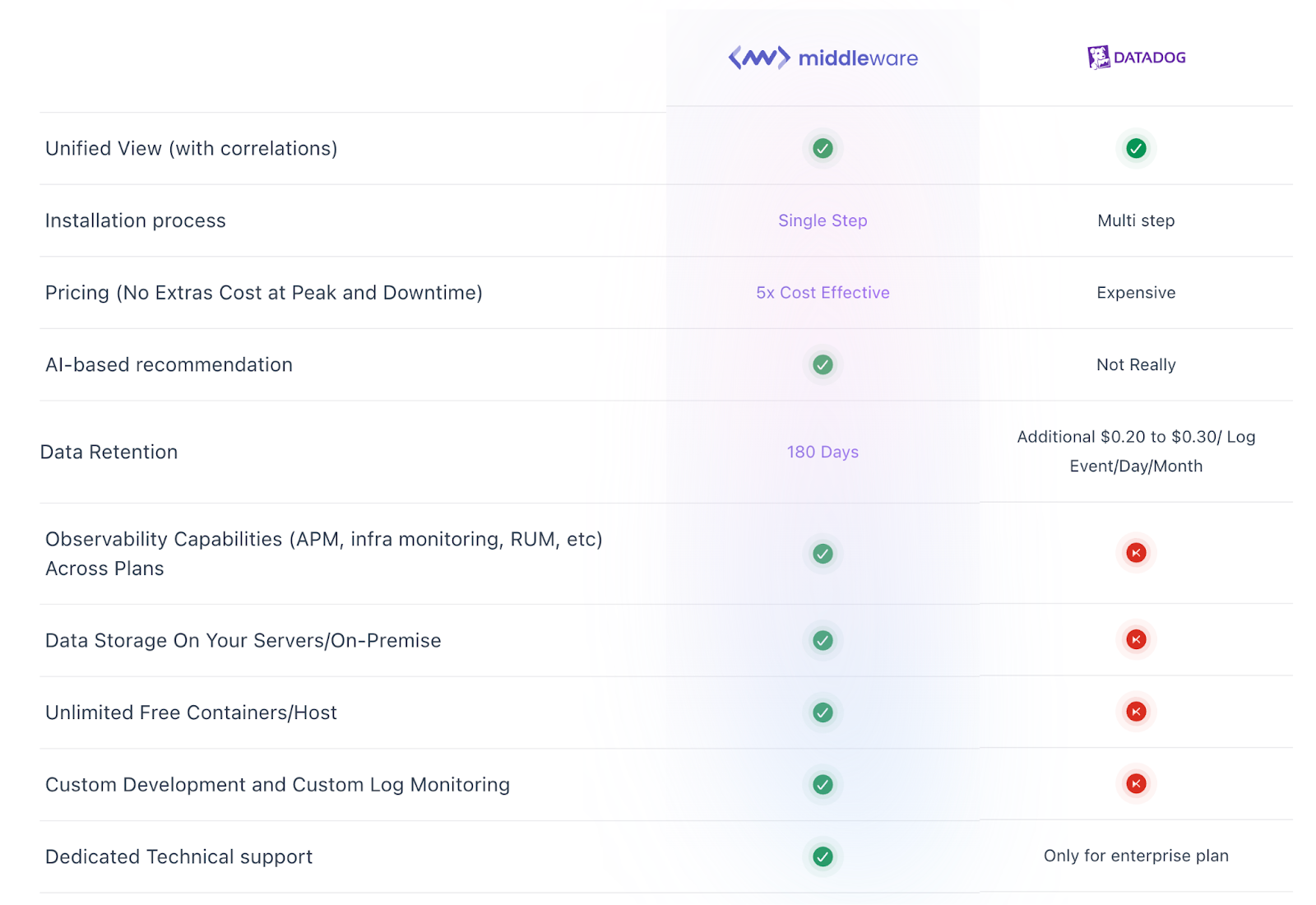
Middleware offers a transparent pricing model with no hidden charges or overage penalties, making it a more predictable and affordable choice. In contrast, Datadog’s pricing model can lead to overage fees and high minimums. With Middleware, customers have reported a 5x reduction in costs.
Unlike Datadog, Middleware provides total data control, allowing users to filter out sensitive data and maintain privacy. This ensures that users have complete control over their data and can maintain compliance with data protection regulations.
Middleware provides actionable insights with detailed root cause analysis and solution recommendations, spanning infrastructure, serverless, Kubernetes, DB, and applications. This enables users to troubleshoot 4x faster and optimize their systems more effectively. Additionally, customers have reported a 3x increase in speed with Middleware.
Overall, Middleware offers a more cost-effective, efficient, and secure alternative to Datadog, with a focus on predictable pricing, data control, and faster troubleshooting.
What are the people saying?
We analyzed user reviews on G2, a leading software buying marketplace, to see what users are saying about both of the tools:
Datadog’s review on G2
Datadog has a rating of 4.4 stars out of 5 on G2, with a majority of reviews mentioning their steep learning curve:

Middleware’s review on G2
Middleware holds a rating of 4.5 stars out of 5 on G2. We analyzed our reviews, and some users referred us to a leading cost-effective Datadog alternative:

Is Datadog’s price worth it in 2025?
As of 2024, evaluating the worthiness of Datadog’s pricing requires considering various factors. One aspect that is not well-received about Datadog is its billing and support system. Users have reported difficulties in resolving deployment mistakes and billing issues.
Some users have felt frustrated by the lack of support and the inability to drop metrics from agents or adjust billing accordingly. This highlights the need for better flexibility and responsiveness in addressing customer concerns.
We ran into multiple configuration issues that Datadog’s support team wasn’t able to resolve quickly. At one point, we were even told to remove sources from the platform or face an account closure, which wasn’t very customer-friendly
Elijah Smith, Software Engineer III at Generation Esports
In comparison, Middleware emerges as a potential alternative that offers a more favorable solution. With Middleware’s straightforward pricing models and user-friendly billing system, users can avoid the complications and frustrations associated with unexpected charges or difficulties in adjusting usage.
The thing that immediately attracted me to Middleware was its ability to undercut Datadog in pricing. As a startup, we’re always looking for ways to reduce costs and increase efficiency, and Middleware’s pricing made a lot more sense for us.
Aaron Hawkey, Co-Founder & CTO, Generation Esports
On top of that, Middleware’s specialized focus on infrastructure monitoring, synthetic monitoring, APM, and real user monitoring ensures a targeted and efficient approach to meeting monitoring needs.
See how Middleware helped Generation Esports migrate from Datadog, cutting observability costs and improving MTTR by 75%—click here to learn more!




